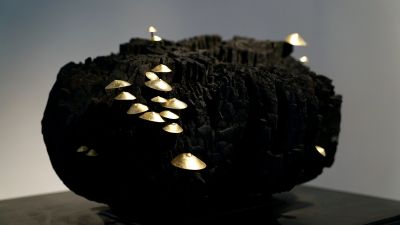A young woman is swaddled in a chrysalis, ready to hatch into a new femininity. Her carefully sculpted, calm face exudes a poetic quality that exists on the edge of death and rebirth. She will soon emerge into an uncertain land that offers dreams and utopias. Is she Ophelia from the future? Plastic cocoons her body, suggesting the advent of new genetic processes that will seal our long descendance from Homo Sapiens.
"Is it science fiction? No, it is a waiting room from the future", Elisabeth Daynès answers. The artist, who works with paleogeneticists, anthropologists and biologists, is known for the faces and bodies of cavemen she recreates for museums and prehistoric sites. Within Evolution, a Neanderthal looks at us with irony, his arms crossed, wondering what we inherited from our ancestors and what generational abyss we are headed towards. A curious, hyper-realistically sculpted man asks himself the same question, as he peers into a relief of a flayed face through the prism of Alioscopy technology. A worrying otherworldliness manifests from this monstrous double of ourselves.
Monsters seem to have infiltrated the physical preoccupations of our time, haunted by the spectre of genetics and hybridization, for better or for worse. It cannot be mere coincidence that questions of gender, sexuality, and identity are raised at a time when social networks are turning human bodies into guinea pigs, ready to mutate in the name of the diktat of the beauty. Is there a genetic nightmare in sight? Probably...
Daynès speculates that we will soon be birthed from small hulls, resembling vulvas, that grow on charred trees. After visiting several research laboratories working on synthetic skin, she began questioning the scientific process of grafting. Her works emulate a hybridization of the living, and suggest augmented, artificial properties that interfere in the evolution of species. "This is a crazy time to be living in, with new norms, new mutations," she observes. Passionate and anguished, she emphasizes the generational madness in holding Kardashian behinds and blistered lips as the pinnacle of beauty. Today, it is possible to change breasts as easily as it is to change dresses. The sixteen-year-old girls who get their mouths plumped often forget that these acts of cosmetic surgery are, for some, irreversible...
A sculpture of proliferating breasts in the form of black charcoal and golden mushrooms suggest a different paradigm, where the womb will no longer serve for fertilization. Occasionally nightmarish and unpleasant, yet pop and grotesque, Daynès’ creations are futuristic anticipations of the Anthropocene, where the artist is unafraid to introduce a certain derision towards these new identities. Where do we come from, what are we, and where are we going?
- Julie Chaizemartin, Journalist and Art Critic
(Translation by Alexandra Gilliams)








